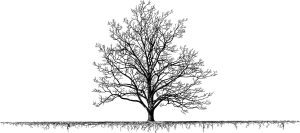I’m not sure why, but work is all about roots at the moment – roots, roots and more roots; or fewer roots as the case may be, mainly because developer X has had them surgically removed with an excavator.
The main problem with roots is that we don’t know always know where they are, and if we don’t know where they are how can we expect developer X and his band of merry 12-tonne digger driving surgeons to know?
Recently published scientific research* suggests that an appropriate root protection area would be a radial distance equal to fifteen (15) times the trunk diameter measured at breast height and that a root protection area of twelve (12) times the trunk diameter, as per most tree protection standards is insufficient.  This, I’m sure is not good news for developer X and his surgical team. But fret not this is only awkward, the complicated bit hasn’t started.
This, I’m sure is not good news for developer X and his surgical team. But fret not this is only awkward, the complicated bit hasn’t started.
The science behind our standards is based on uniform lateral root spread – roots spreading out evenly like a circle centred on the tree. To account for reality putting a square peg in round hole, Standards add in conditions, exceptions and possible variations; ‘where pre-existing site conditions or other factors indicate that rooting has occurred asymmetrically’, we need to adjust the shape of the root protection area accordingly, ‘a polygon of equivalent area should be produced.’ One does love a good polygon, doesn’t one.
So, what are these ‘polygon forming factors’ that indicate that asymmetrical rooting has occurred, what are these factors that indicate there may be a possible deviation from the original circular root-plot-pattern? Standards ask us to factor in the presence of structures and underground apparatus, topography, drainage, the soil type and soil structure. Standards ask us to look at the site.
In Standards defence, they are trying to produce guidelines for every tree, growing in every soil in every possible site and/or situation – it’s a big ask, and they have given us a starting point. Science, on the other hand, hasn’t bothered – how can you plot root growth for every tree, growing in every soil in every possible situation? But Science has told us where the roots could be, and by doing so have made Standards starting point defendable. Fantastic, so where are the roots?
Because we don’t know with any real certainty where the roots are, we guess; ‘a soundly based arboricultural assessment is undertaken to determine root distribution’. In an ideal world we would all have the time and all the tools, and in the case of an ‘air spade’ someone else to use them – but sometimes the job or the tree or the hole isn’t that big, so we have to make a calculated guess. Our guess is often based on experience and the realities of the site as we see it, but more often than not we forget that trees can’t read – trees often don’t do or grown as they should do, according to common literature at least.
So how are we supposed to work out where the roots are? To answer this question, we need to have a Ted Green moment. Ted will ask you, what is a tree? and then he will mercilessly deconstruct whatever answer you give him – my Ted Green question is; why do trees exist?
The ‘why do trees exist’ question is a good one, but unlike Ted’s question it has a simple answer, and knowing the answer, explains the meaning of life, the universe, and everything, (and no, the answer is not 42). Trees exist to reproduce – to make more trees. This seemingly simple statement explains over half of all arboriculture conundrums. Everything that a tree does, that isn’t directly involved in reproduction or assisting in reproduction in some way shape or form, is a waste of time. Trees won’t produce uniform lateral root spread if they don’t need to, in the same way, that they won’t carry on putting down reaction wood if they don’t need to, or grow a branch to fill a gap, or select one competing leader over the other, or respond to load if there is no load or stop growing towards the powerlines or… the list goes on. Trees are single focus organisms.
So how does this help us locate roots? If a tree is getting what it needs from a bit of soil then it is unlikely to invest more growth elsewhere, or turn that around; if it is not getting what it needs from that bit of soil then it is unlikely to invest more growth in that bit of soil – look for roots in the polygon of good soil and expect to find fewer in the circle of bad soil. Remember that trees can’t read, but they can reproduce – so if your tree isn’t going to fall over and it has found a source of water and nutrients (i.e. a drain) then why would invest in growing roots elsewhere – why bother growing roots when you can set seed? And no, roots can’t break pipes – if there is a leak, they will exploit it and once in the pipe may break, but roots can’t force their way in.
So when looking for roots, always start with the polygon of good before moving into the circle of bad.
* A test of tree protection zones: Responses of Quercus virginiana Mill trees to root severance treatments. Benson, A. Koeser, A and Morgenroth J. (2019) Urban Forestry and Urban Greening. V38 P54-63
0 Comments